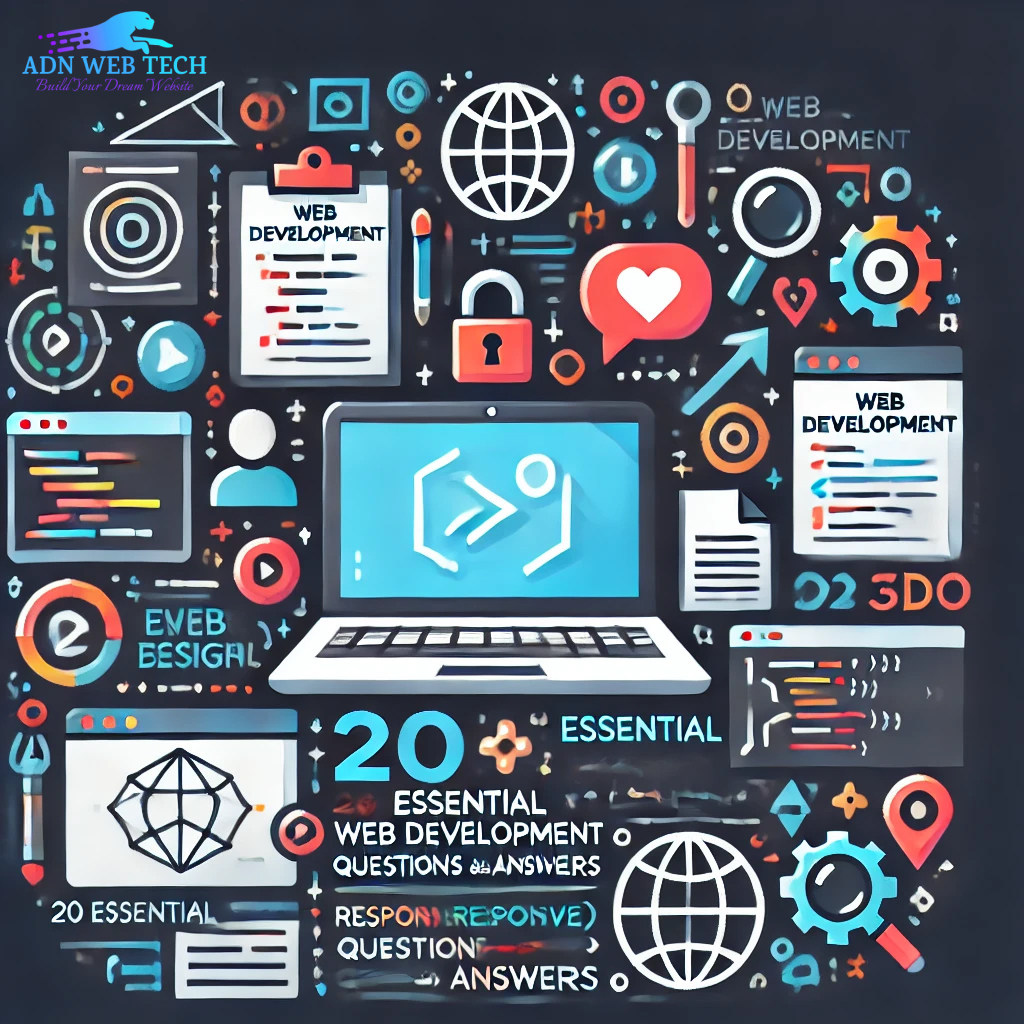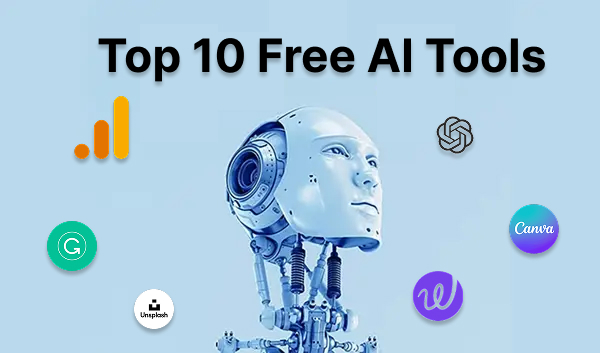
20 Essential Web Development Questions and Answers
1. What Is the Difference Between Frontend and Backend Development?
Answer: Frontend development involves creating the parts of a website that users interact with directly, such as layout, design, and interactivity. Common frontend technologies include HTML, CSS, and JavaScript. Backend development, on the other hand, focuses on server-side operations like database interactions, server logic, and API integration. Technologies used in backend development include Node.js, PHP, Ruby, Python, and SQL databases.
2. Explain CSS Flexbox and When to Use It.
Answer: CSS Flexbox is a layout module that provides a simple way to align and distribute space among items in a container. Flexbox is ideal for layouts where elements need to be aligned in a single direction (row or column) and for centering items. It simplifies tasks like responsive menus, card layouts, and element alignment without using floats or positioning.
3. What Are CSS Grids, and How Are They Different from Flexbox?
Answer: CSS Grids provide a two-dimensional layout system, allowing items to be positioned in rows and columns. Unlike Flexbox, which is one-dimensional, CSS Grid is suitable for creating complex layouts, like grids of images or product listings, where both rows and columns need control. Flexbox is better for simpler layouts, while Grid excels in more complex layouts.
4. What Is the Document Object Model (DOM)?
Answer: The DOM is a programming interface for HTML and XML documents. It represents the structure of a document as a tree, where each element, attribute, and piece of content is a node. JavaScript can interact with the DOM to dynamically change a webpage’s structure, style, and content based on user interactions.
5. How Does Asynchronous JavaScript and XML (AJAX) Work?
Answer: AJAX is a technique used to send and receive data asynchronously from a server without refreshing the page. It allows web applications to update parts of a page based on server responses, which improves user experience by reducing load times. AJAX uses technologies like XMLHttpRequest, Fetch API, and often integrates with JavaScript libraries like jQuery.
Click To Inquiry For Book Our Service
6. What Is Responsive Design, and Why Is It Important?
Answer: Responsive design ensures a website looks and functions well on various screen sizes, from desktops to smartphones. It involves using flexible layouts, media queries, and responsive images. Responsive design is essential because it provides a better user experience across devices and is a key factor in SEO ranking.
7. How Does a REST API Differ from a GraphQL API?
Answer: REST is an architectural style that uses HTTP requests to access and manipulate data via standard methods (GET, POST, PUT, DELETE). GraphQL, however, is a query language allowing clients to request specific data. REST APIs are suitable for simpler data structures, while GraphQL is beneficial for complex queries, reducing the number of requests by retrieving only the needed data.
8. What Are Single Page Applications (SPAs)?
Answer: SPAs load a single HTML page and dynamically update content based on user interactions without reloading the page. Popular frameworks for SPAs include React, Vue, and Angular. SPAs provide a smooth user experience by reducing page load times, but they require careful handling of routing and state management.
9. What Is the Virtual DOM, and How Does It Work?
Answer: The Virtual DOM is an in-memory representation of the actual DOM. JavaScript frameworks like React use it to minimize direct DOM manipulation by comparing changes (diffing) and updating only the necessary parts of the real DOM. This process makes updates faster and improves app performance.
10. What Is CORS, and Why Is It Important?
Answer: CORS (Cross-Origin Resource Sharing) is a security feature that allows servers to specify who can access their resources from a different domain. It prevents malicious websites from making unauthorized requests on behalf of a user. CORS is configured on the server to allow or restrict access based on origins.
11. How Do You Optimize a Website for Faster Loading Times?
Answer: Some common techniques include:
- Minimizing CSS, JavaScript, and HTML files.
- Using image compression and next-gen formats like WebP.
- Leveraging browser caching.
- Using a Content Delivery Network (CDN) to reduce latency.
- Minimizing HTTP requests by combining files or using lazy loading.
12. What Is the Purpose of Webpack in Web Development?
Answer: Webpack is a module bundler for JavaScript applications. It compiles modules (JavaScript, CSS, images, etc.) into a single file or a set of files, reducing the number of requests. Webpack also allows code splitting, bundling assets, and managing dependencies, making it essential for optimizing performance in large applications.
13. Explain the Box Model in CSS.
Answer: The CSS Box Model describes how elements are structured on a page. Each element has a content area surrounded by padding, a border, and margin. Understanding the Box Model is essential for accurate element sizing and layout adjustments.
14. What Is the Purpose of Git in Web Development?
Answer: Git is a version control system that allows developers to track and manage changes to code. It enables collaboration, as developers can work on different features without overwriting each other's changes. Git also makes it easy to roll back to previous versions if needed.
15. What Are Media Queries in CSS?
Answer: Media queries allow developers to apply styles based on device characteristics, like screen width or resolution. They’re essential for responsive design, enabling layout adjustments for different screen sizes.
16. What Are Progressive Web Apps (PWAs)?
Answer: PWAs are web applications that use modern web capabilities to deliver an app-like experience on mobile and desktop. They are installable, work offline, and support push notifications. PWAs offer a balance between native apps and regular websites.
17. Explain the Purpose of Cookies, Local Storage, and Session Storage.
Answer: These are client-side storage solutions:
- Cookies: Store small amounts of data with an expiration date, used for tracking sessions and preferences.
- Local Storage: Stores larger data persistently without an expiration, suited for storing user preferences.
- Session Storage: Stores data temporarily for a single session, cleared when the browser is closed.
18. What Are the Key Differences Between jQuery and Vanilla JavaScript?
Answer: jQuery is a JavaScript library that simplifies DOM manipulation, event handling, and AJAX requests. Vanilla JavaScript refers to using JavaScript without libraries. Modern JavaScript has closed many gaps that jQuery filled, but jQuery remains useful for quick DOM manipulation and cross-browser compatibility.
19. How Do You Implement Dark Mode in a Website?
Answer: Dark mode can be implemented using CSS variables and media queries. For example:
:root {
--bg-color: white;
--text-color: black;
}
@media (prefers-color-scheme: dark) {
:root{
--bg-color: black;
--text-color: white;
}}
body {
background-color: var(--bg-color);
color: var(--text-color);
}
Using JavaScript, users can toggle between modes.
20. What Are Some Best Practices for Writing Clean, Maintainable Code?
Answer: Key best practices include:
- Modular Code: Break code into reusable modules.
- Naming Conventions: Use descriptive names for variables and functions.
- Documentation: Add comments and documentation.
- Consistent Formatting: Use linters and formatters to maintain consistency.
- Avoid Hard-Coding: Use variables and functions for values that may change.
These practices improve code readability and make future updates easier.
These questions and answers cover essential knowledge and trends in web development, providing a valuable resource for developers preparing for interviews or looking to deepen their understanding.





